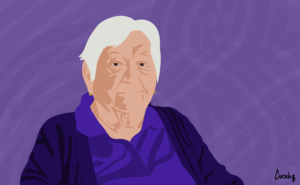
“In Tunisia we suffer & die from Racism. We have been neglected by the UN agencies. Betrayed by the international community. But we will fight for our dignity”
This is the “bio” for the Twitter page, “Refugees in Tunisia”. It was created amid protests by predominantly Black migrants in Tunis in 2023 and exemplifies migrant self-representation. It also demonstrates a platform through which the experiences of migrant protestors navigating their circumstances were broadcast into the public sphere and their interactions were recorded.
When discussing migration policies and practices, there is often a focus on the violence used to secure the ever-expanding edges of Europe’s bordering practices. The concept of “Fortress Europe” and its implications frequently casts a daunting shadow over refugees and migrants seeking safe pathways to Europe. However, what about refugee and migrant resistance to these practices? While highlighting the negative impacts of European-driven migration policies is crucial, it is equally important to discuss how refugees and migrants are active players in EU-driven border policies.
This is why migrant protest is important. Protest serves as a vital tool for refugees and migrants to make the unfairness of their treatment visible and challenge perceptions of their powerlessness. In particular, migrant protest in non-Western contexts directed towards international organizations like the UNHCR illuminates the disconnections between institutions and the migrants they claim to support in their policies and funding, placing a spotlight on the roles that IOs play in the violent management of migration. To illustrate the significance of the 2023 migrant protest in Tunis in particular, we need to first examine the context in which they arose.
What led to the 2023 migrant protests in Tunis?
Several developments set the stage for the 2023 migrant protests in Tunis. By 2023, Tunisia had become a key transit point in the landscape of Mediterranean migration, shifting from Libya due to increasingly violent border controls. For example, the Tunisian Interior Ministry reported intercepting 70,000 migrants attempting Mediterranean crossings in 2023 alone, with 77.5% of intercepted migrants originated from Sudan, Chad, and West African countries like Guinea and Nigeria. These statistics represent a stark contrast to the previous year in which 31,297 people on the move were intercepted making irregular maritime journeys.
Within Tunisia, the rising authoritarianism of the Tunisian state under President Kais Saied has been bolstered by strategic, 150 million Euro agreements with the EU that aim to transfer migration management responsibilities to Tunisian authorities. This has increased the capacity of the Saied administration to incite and enact violence against sub-Saharan African refugees and migrants.
In practice, this violence includes capitalizing upon ethno-nationalist rhetoric by framing the 21,000 Black migrants present in Tunisia (a country of approximately 12 million people) as threatening the country’s demographic makeup as an “Arab” country. It also includes expulsions into the desert, (resulting in the deaths of people such as Matyla Dosso and her six-year old daughter Marie Dosso), forced displacement, and increased arrests of smugglers.
Additionally, the 2023 migrant protests in Tunis were preceded by earlier demonstrations. Beginning in February 2022, Sudanese and other Black migrants protested against the UNHCR in the small fishing town of Zarzis, demanding evacuation due to neglect of their circumstances. by the international community.
Despite moving their protest to Tunis after a violent police eviction in April 2022, protestors faced further violence, including the death of protestor Mohammed Faraj Momin. These earlier protests Tunisia set an important precedent for the troubling trajectory towards violence that occurs when migrants protest against international organizations.
A timeline of the 2023 migrant protests in Tunis
21st – 22nd February 2023 – President Kais Saied Incites Racial Violence The President’s remarks in a National Security Council meeting about the threat of sub-Saharan migrants to Tunisia’s “Arab” identity of incites anti-Black violence, such as targeted evictions and anti-Black mobs described by one journalist as “pogroms”. Seeking safety, Black migrants begin gathering together in a camp outside of the International Organization for Migration’s Tunis offices.
27th February 2023 – Informal Camp Construction Begins
“Where can we go now?” Black migrants begin constructing an informal camp in front of the UNHCR Tunis offices and begin protesting to receive attention from the UNHCR.
“After one week, too much people joined us [at the IOM camp], refugees and immigrants. We discuss among us, we need to go to the UNHCR…we need to go to the UNHCR. Because the IOM is especially for those who like to go back to their homes, or those wanting to be resettled in their countries. But we need a future. We don’t want to go back to our homes”
30th March 2023 – “Refugees in Tunisia” is Created
“Refugees in Tunisia” makes its first Twitter post to bring attention to their circumstances and record their experiences. Self- identifying as Black refugees and immigrants participating in a “sit-in”, the captions, protest signs, and chanting articulate clear demands for evacuation to the UNHCR:
“We immigrants are not safe. We are not being protected by the organizations that are supposed to protect us”
“Where are we supposed to go, there are wars in our countries? Now even the citizens are ganging up against us?”
10th April – Violence Police Eviction
Tensions between the UNHCR, migrant protestors and Tunisian police reached a boiling point when the UNHCR called on the Tunisian police to evict the migrant camp in front of the UNHCR. Protestors describe graphic police violence, including tear gas, beatings, and imprisonment.
From the “Refugees in Tunisia” Twitter account:
“Post (1 of 4): The police arrived at 9am and continued to provoke us, but we held our breath, but when they continued to shoot you, the situation became crazy. Some cars were smashed because the police fired banyans to disperse us.
Post (2 of 4): We were attacked by the security personnel who were called by the #UNHCR to break up our sit-in by force. When we tried to defend ourselves, tear gas and incendiary buildings were fired. We fled to a safe place, but the police told us that UNHCR & IOM had abandoned us.
Post (3 of 4): and we should be able to go anywhere within 5 minutes. We decided to take refuge except in some embassies to protect ourselves, but we were attacked and beaten with sticks by the police, women, children and men were arrested. Now we have lost more than 80 people
Post (4 of 4): who are being held captive by the security personnels. Most of our spokesperson have been targeted. Some of who managed to flee are still in an open prison at the mercy of everyone. We want to draw attention to human rights activists. We are in dire need of you.”
11th April – Recovery Begins
Protestors begin recovering from the physical and emotional trauma of the eviction. One protestor notes that demoralization and destruction they experienced.
“We are dying here, all the world needs to know and help us. Our brothers in prisons are suffering, we are worried for them. We want evacuation to any country, we cannot return back to our country”
17th May – A Return to Protest?
Some protestors attempt to regroup with a peaceful demonstration outside the European Commission in Tunis.
“Since February of this year we have not been able to breathe from racism and violence. We took our peaceful protest to the Commission headquarters and were violently expelled and imprisoned.
Today we are here with the same demands.
“No to stay”
“Evacuations only”
“Salmiya, Salmiya”
Tunisia is not safe. We are human beings and our rights must be protected and respected All of our rights are being violated”
26th May and 7th June – Protests Continue
Similar posts are made featuring flags from the United States, Canada, European Union, and Palestine as well as a professionally made blue banner featuring the white text, “UNFAIR UN Refusal Agency” – referencing the ties of solidarity between “Refugees in Tunisia” and “Refugees in Libya”.
Despite the protest activity after the police eviction, at this point most attention had moved on from the protest itself and instead turned towards Sfax where the amount of boat crossings were increasing in what several journalists have dubbed “migration season”.

Key conclusions
Reflecting upon the 2023 migrant protests in Tunis also prompts comparisons to other cases of migrant protest against international organizations in non-Western contexts. For example, existing research cites protests by refugees in the UNHCR Buduburam Refugee Camp (Ghana, 1990), protests by Sudanese migrants against the UNHCR (Jordan, 2015), and protests by
“Refugees in Libya” demanding support and evacuation from the UNHCR, inspiring the “UNFAIR campaign” (Libya, 2021). Examining these case studies alongside the migrant protests in Tunisia offers several insights:
1. The labelling of certain types of migration as legitimate or illegitimate can leave refugees and migrants stranded.
● Framing certain methods of movement as “irregular” ultimately reduces the number of options of refugees and migrants have to pursue safe and legal movement across borders.
● Refugees and migrants then have to choose between surviving on the limited resources they have available or pursuing irregularized means of movement. In practice, this can result in people getting caught in a state of limbo.
● Addressing this state of limbo and securing necessary resources then becomes the central goals of migrant protest
● International organizations become protest targets because they position themselves as the provider of support and resources for migrants in non-Western contexts.
2. International organizations can be complicit in the cycles of displacement and resistance refugees and migrant experience.
● In response to the pressure implemented by migrant protests, international organizations have repeatedly instrumentalized police violence against migrants.
● Further observations reveal how interactions between migrants and migration management authorities produce cycles of displacement and resistance that international organizations participate in.
○ Here is an example of these dynamics from the 2023 migrant protests in Tunis:
○ After President Saied’s speech, Black migrants were displaced through mass evictions. (displacement)
○ Those that were evicted resisted their treatment by organizing protests and directing demands for safety towards international organizations. (replacement) ○ Yet, these protests were then met with forced displacement through a violent eviction and police brutality. (displacement)
○ Resistance continued, however, through smaller protests later on or by pursuing regularized Mediterranean crossings. (replacement)
● International organization’s participation in these cycles suggest that, in taking on the role of services provider to fill in the gaps in services left by states, international organizations like the UNHCR also adopt the systemic violences used by institutions to maintain racist border policies.
3. A Call to Action: Migrant protests demonstrate the need for sustainable migrant self-expression platforms to challenge systemic violence.
We need to disrupt the violence of these cycles of displacement and resistance. What migrant protests like the 2023 Tunis case passionately demonstrate is a need for a sustainable space of migrant self-representation that interrupts the violence produced against migrants who seek to resist their displacement. To determine what that looks like, both formal and informal refugee-led organizations (RLOs) need meaningful seats at the table and for their lived experiences to be respected guides for how to address current issues. Until then, the cycle continues.
About the Author: Isabel Jess, currently based in Tangiers, Morocco, is a graduate of the European University Institute in Florence, where she studied on transnational migration policy, focusing on border externalization and migration management practices. Her work in Los Angeles, London, Calais, and Tunis has shaped her perspective on the need for sustainable migration policies that incorporate the lived experiences and agency of people on the move into the negotiation process.
The opinions expressed in this blog are those of the author and do not necessarily represent the views of United Against Inhumanity (UAI).











